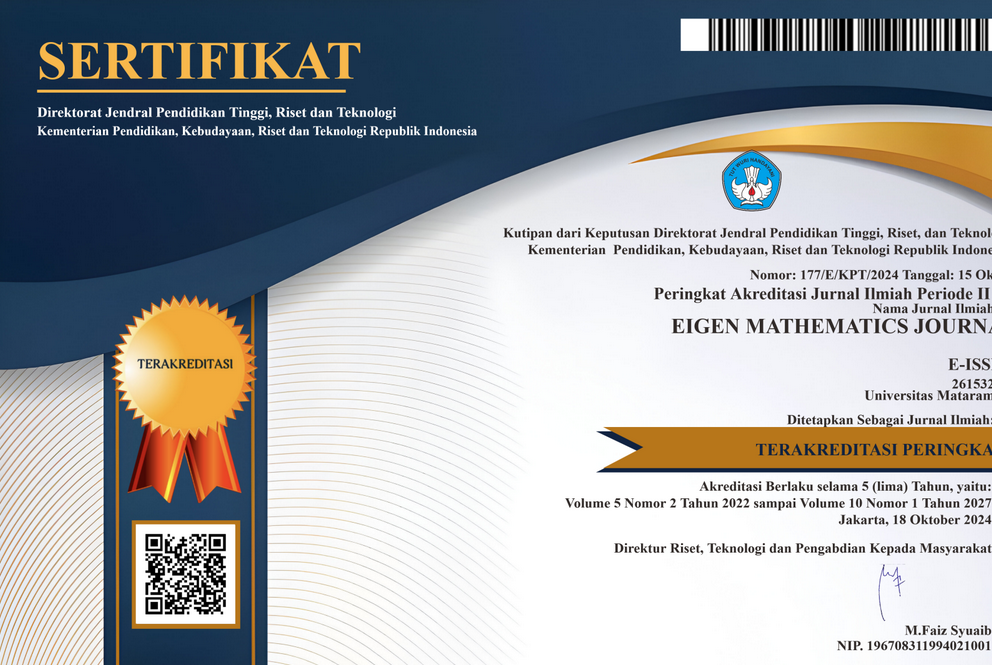Co-Existing Point of Equilibrium in Discretization of Fractional-Order Prey and Predator Model
DOI:
https://doi.org/10.29303/emj.v6i1.169Keywords:
prey, predator, fractional-order, discretization, prey refuge, additional foodAbstract
In this work, a discretization process of a fractional-order prey and predator model is discussed. The aim of this work is to describe the population phenomenon which contains prey and predator. In this research, the prey and predator model by Ghosh et al. (2017) is used. The model has an unique form because it contains prey refuge and additional food to predator. In order to give more details on prey and predator population, the model then modified into fractional order and then discretized. The discretization model has three points of equilibrium and one of them named co-existing point of equilibrium. The numerical simulation is used to perform the stability. The numerical simulation is controlled by using mathematical programming language. It resulted that the co-existing point of equilibrium tends to be stable or converge if a small value of (time step) is selected. Otherwise, if a larger value of is selected, then oscillatory is appeared which means the point of equilibrium become unstable or diverge.References
Elsadany, A. A. dan Matouk, A. E. (2015). Dynamical behaviors of fractional-order Lotka Volterra predator-prey model and its discretization. Journal of Applied Mathematical Computation, 49, 269-283.
Ghosh, J., B. Sahoo, S. Poria. (2017). Prey-predator dynamics with prey refuge providing additional food to predator. Journal of Chaos Solitons Fractals, 96, 110-119.
Jana, Debaldev., Banarjee, Aniket., and Samanta, G. P., (2017). Degree of prey refuges: Control the competition among prey and foraging ability of predator. Journal of Chaos, Solitons and Farctals, 104, 350-362.
Li, Jing., Jin, Zheng., Sun, Gui-Quan. (2016). Periodic solutions of a spatiotemporal predator-prey system with additional food. Journal of Chaos, Solitons and Fractal, 91, 350-359.
Lotka, A. J. (1925). Element of physical biology. William and Winlkins. Baltimore.
Miller, K.S., B. Ross. (1988). Fractional difference calculus. In: Proceedings of the International Symposium on Univalent Functions, Fractional Calculus and Their Applications. Nihon University, Koriyama, Japan. Journal Ellis Horwood Ser. Math. Appl. Horwood, Chichester, 139-152.
Petras, I. (2011). Fractional order nonlinear models. Higher Education Press, Beijing, and Springer-Verlag. Berlin Heidelberg.
Prasad, B. S. R,V., Banarjee, Malay, & Srinivasu, P. D. N. (2013). Dynamics of additional food provided predator-prey system with mutually interfering predators. Journal of Mathematical Bioscience, 246, 176-190.
Volterra, V. (1931). Lecons sur la theorie mathematique de la lutte pour la vie. Gauthier-Villars. Paris.
Wang, Hao., Thanarajah, Silogini., & Gaudreau, Philippe. (2017). Refuge-mediated predator-prey dynamics and biomass pyramids. Accepted manuscript. University of Alberta.
Downloads
Published
How to Cite
Issue
Section
License

This work is licensed under a Creative Commons Attribution-NonCommercial-ShareAlike 4.0 International License.
All articles published in the Eigen Mathematics Journal will be available for free reading and downloading. The license applied to this journal is Creative Commons Attribution-Non-Commercial-Share Alike (CC BY-NC-SA).






